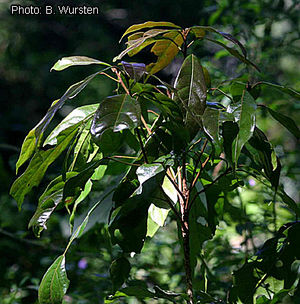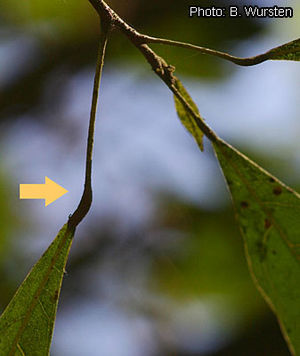Cola greenwayi (PROTA)
Introduction |
Cola greenwayi Brenan
- Protologue: Kew Bull. 1956: 144 (1956).
- Family: Sterculiaceae (APG: Malvaceae)
Synonyms
- Cola microcarpa Brenan (1956).
Vernacular names
- Hairy cola (En).
Origin and geographic distribution
Cola greenwayi is distributed in DR Congo, Kenya, Tanzania, Malawi, Zambia, Namibia, Zimbabwe, Mozambique and South Africa.
Uses
The wood of Cola greenwayi is used for construction, tool handles, bows, pegs, animal traps, firewood and charcoal. It is used in traditional medicine, but uses are unspecified.
Properties
The wood is heavy, hard and tough. Ethanol and dichloromethane extracts of the twigs have shown anti-inflammatory activity, and an ethyl acetate extract moderate antibacterial activity.
Description
- Evergreen, usually dioecious, medium-sized tree up to 24 m tall; bole up to 50 cm in diameter; bark pale brown to grey, rough; young branches densely dark brown hairy.
- Leaves alternate, simple and entire; stipules subulate-lanceolate, 3–6 mm long, caducous, brown hairy; petiole up to 6 cm long, with pulvinus just below the blade; blade elliptical to oblanceolate or obovate-elliptical, up to 15 cm × 7 cm, thinly leathery, base broadly cuneate or narrowly rounded, apex obtusely acuminate, glabrous on both sides at maturity, purplish red when young, pinnately veined with 8–12 pairs of lateral veins. Inflorescence an axillary fascicle on 1–3-year-old branches.
- Flowers unisexual, rarely some bisexual, regular; calyx 6–11.5 mm long, deeply 4–6-lobed, tube up to 1.5 mm long, lobes elliptical to obovate-elliptical; corolla absent; male flowers on jointed pedicel 4–7 mm long, androphore 2.5–4.5 mm long with 5–12 sessile anthers in a single row around the apex and 4 rudimentary carpels immersed in the top; female flowers with pedicel up to 1(–2) cm long with part above joint markedly grooved, ovary superior, consisting of 3–5 carpels, styles up to 3 mm long, rudimentary stamens 5 at base of carpels.
- Fruit consisting of 4–5 obliquely ellipsoid to obovoid follicles 1–2 cm × 1.5–2 cm, apex rounded or mucronate, orange-yellow to deep orange when ripe, rusty hairy, 1–2-seeded.
- Seeds ellipsoid, 13–16 mm × 8–11 mm, testa brown, somewhat wrinkled.
Other botanical information
In Zimbabwe Cola greenwayi flowers in October–November. Cola comprises about 100 species and is restricted to continental Africa.
Ecology
Cola greenwayi occurs in dense woodland or evergreen forest up to 2200 m altitude.
Genetic resources
Cola greenwayi has a wide distribution and there are no indications of threat by genetic erosion.
Prospects
The wood of Cola greenwayi is locally used for various purposes. Too little information is available on its wood properties to assess its potential for wider use.
Major references
- Lovett, J.C., Ruffo, C.K., Gereau, R.E. & Taplin, J.R.D., 2006. Field guide to the moist forest trees of Tanzania. [Internet] Centre for Ecology Law and Policy, Environment Department, University of York, York, United Kingdom. http://www.york.ac.uk/res/celp/webpages/projects/ecology/tree%20guide/guide.htm. April 2006.
- Verdoorn, I.C., 1981. The genus Cola in southern Africa. Bothalia 13(3–4): 277–279.
- Wild, H. & Gonçalves, M.L., 1979. Sterculiaceae. In: Mendes, E.J. (Editor). Flora de Moçambique. No 27. Junta de Investigações Científicas do Ultramar, Lisbon, Portugal. 57 pp.
Other references
- CJB & SANBI, 2006. African Flowering Plants Database. [Internet] Conservatoire et Jardin botaniques de la Ville de Genève (CJB) and South African National Biodiversity Institute (SANBI), Pretoria, South Africa. http://www.ville-ge.ch/cjb/bd/africa/index.php September 2006.
- Germain, R. & Bamps, P., 1963. Sterculiaceae. In: Robyns, W., Staner, P., Demaret, F., Germain, R., Gilbert, G., Hauman, L., Homès, M., Jurion, F., Lebrun, J., Vanden Abeele, M. & Boutique, R. (Editors). Flore du Congo belge et du Ruanda-Urundi. Spermatophytes. Volume 10. Institut National pour l’Étude Agronomique du Congo belge, Brussels, Belgium. pp. 205–316.
- Hyde, M.A., 2004. Flora of Zimbabwe checklist: Sterculiaceae. Version 1.2. [Internet] http://www.zimbabweflora.co.zw/fams1.2/sterculiac.php. May 2006.
- Reid, K.A., Jäger, A.K., Light, M.E., Mulholland, D.A. & van Staden, J., 2005. Phytochemical and pharmacological screening of Sterculiaceae species and isolation of antibacterial compounds. Journal of Ethnopharmacology 97(2): 285–291.
- Wild, H., 1961. Sterculiaceae. In: Exell, A.W. & Wild, H. (Editors). Flora Zambesiaca. Volume 1, part 2. Crown Agents for Oversea Governments and Administrations, London, United Kingdom. pp. 517–564.
Author(s)
- M. Brink, PROTA Network Office Europe, Wageningen University, P.O. Box 341, 6700 AH Wageningen, Netherlands
Correct citation of this article
Brink, M., 2007. Cola greenwayi Brenan. In: Louppe, D., Oteng-Amoako, A.A. & Brink, M. (Editors). PROTA (Plant Resources of Tropical Africa / Ressources végétales de l’Afrique tropicale), Wageningen, Netherlands. Accessed 18 December 2024.
- See the Prota4U database.


